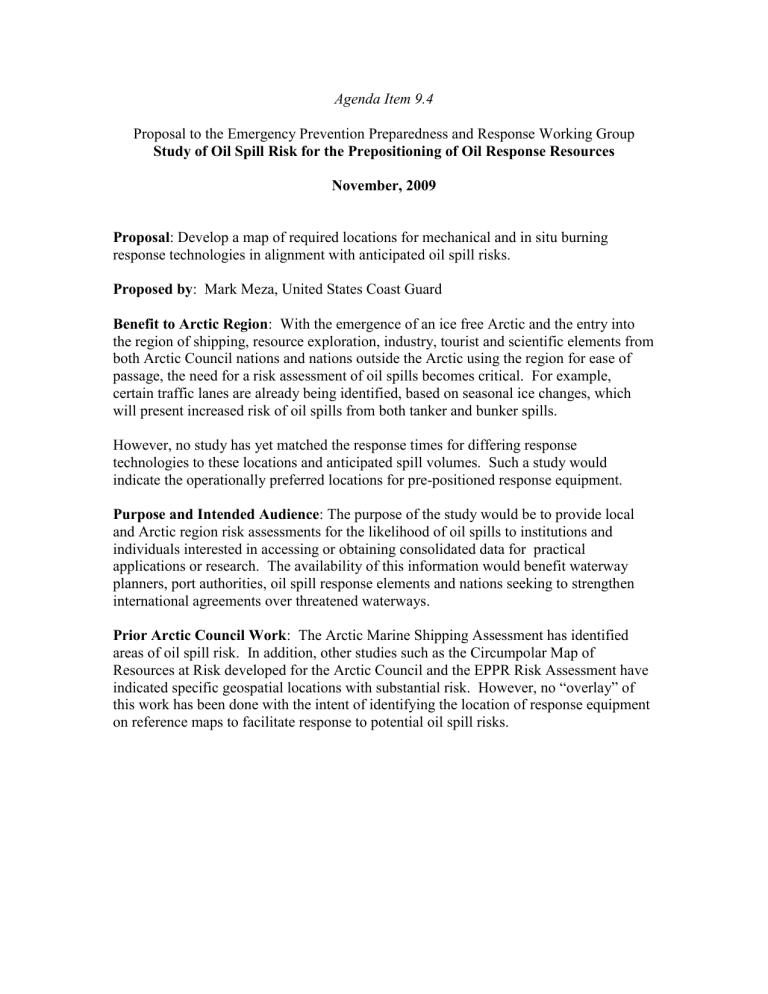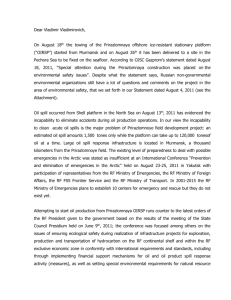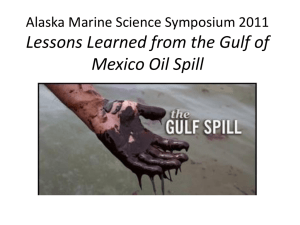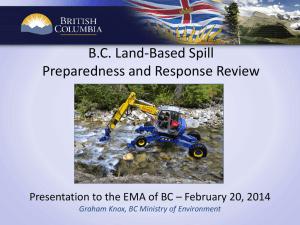Proposal to the Emergency Prevention, Preparedness and

Agenda Item 9.4
Proposal to the Emergency Prevention Preparedness and Response Working Group
Study of Oil Spill Risk for the Prepositioning of Oil Response Resources
November, 2009
Proposal : Develop a map of required locations for mechanical and in situ burning response technologies in alignment with anticipated oil spill risks.
Proposed by : Mark Meza, United States Coast Guard
Benefit to Arctic Region : With the emergence of an ice free Arctic and the entry into the region of shipping, resource exploration, industry, tourist and scientific elements from both Arctic Council nations and nations outside the Arctic using the region for ease of passage, the need for a risk assessment of oil spills becomes critical. For example, certain traffic lanes are already being identified, based on seasonal ice changes, which will present increased risk of oil spills from both tanker and bunker spills.
However, no study has yet matched the response times for differing response technologies to these locations and anticipated spill volumes. Such a study would indicate the operationally preferred locations for pre-positioned response equipment.
Purpose and Intended Audience : The purpose of the study would be to provide local and Arctic region risk assessments for the likelihood of oil spills to institutions and individuals interested in accessing or obtaining consolidated data for practical applications or research. The availability of this information would benefit waterway planners, port authorities, oil spill response elements and nations seeking to strengthen international agreements over threatened waterways.
Prior Arctic Council Work : The Arctic Marine Shipping Assessment has identified areas of oil spill risk. In addition, other studies such as the Circumpolar Map of
Resources at Risk developed for the Arctic Council and the EPPR Risk Assessment have indicated specific geospatial locations with substantial risk. However, no “overlay” of this work has been done with the intent of identifying the location of response equipment on reference maps to facilitate response to potential oil spill risks.
Agenda Item 9.4
Proposal to the Emergency Prevention Preparedness and Response Working Group
Operational Manual for In Situ Burning in Oil Spill Response
November, 2009
Proposal
: Develop a detailed, “how to” operations manual for igniters, containment devices, ignition procedures, and air and water monitoring for use in remote locations.
Proposed by : Mark Meza, United States Coast Guard
Benefit to Arctic Region : There has not been a compilation of practical in situ burning operating guidelines for cold water application. This has created a gap between publications which generally discuss the science of in situ burning applications and individual product brochures which direct the proper processes for the use of igniters.
Further, some aspects of in situ burning such as the addition of burning agents have not been clearly discussed in terms of proper application in most response publications. This gap has created a barrier for local and regional response authorities who would like to assess the possibility, limitations, and infrastructure costs of in situ burning as well as to establish operating procedures for burning as a response option. The In Situ Burning
Operations Manual in Oil Spill Response would fill this gap and provide a valuable resource for use in remote locations.
Purpose and Intended Audience : The in situ operations manual would be designed for use by port authorities, waterways mangers, and spill response organizations with practical interest in situ burning, its strengths, limitations, and proper application and use. The In Situ Burning Operations Manual in Oil Spill Response would address equipment such as vessels and aircraft, igniters, fire boom, residue collection, ignition additives, and health monitoring.
Prior Arctic Council Work : Brief, general discussion is available in the EPPR Working
Group developed Arctic Waters Field Guide. However, no detail operationally focused manual has been developed.
Agenda Item 9.4
Proposal to the Emergency Prevention Preparedness and Response Working Group
Operational Manual for Oil Disposal
November, 2009
Proposal: Develop a detailed operational manual on techniques for disposal of recovered petroleum products and related materials in remote locations.
Proposed by : Mark Meza, United States Coast Guard
Benefits to Arctic Region: Different response tactics generate two types of waste types: liquids and solids. Further segregation separates oily versus non-oily materials that can be disposed through different techniques. In addition, waste reduction or repackaging at or near the collection site, such as oil/water separation, emulsion breaking, and snow/ice melting, may minimize waste handling and transport requirements.
However, ultimately no more oil may be recovered than can be safely disposed. Final disposal may occur at the recovery site or at an alternate, but more remote location. Final disposal options may range from incineration at the recovery site for energy creation to sophisticated recycling and processing for use in building materials or for energy generation at a central location. Each disposal option has strengths and weaknesses, along with tangential costs such as transportation, or further creating environmental challenges involving contamination of the air, ground, or water.
The decisions regarding response tactics will identify, for planning purposes, the primary types and amounts of waste that will be generated. No plan can be complete without assessing disposal options against the types and amounts of waste generated.
Purpose and Intended Audience: The purpose of the Operations Manual for Oil
Disposal is be to provide detailed guidance on disposal options and the factors which musts be weighed in their adoption. Such a reference could be used in contingency planning and response operations decision making.
Prior Arctic Council Work: Current, significant work has been done in estimating spill volumes for collection with the publication of the EPPR Working Group Guidelines and
Strategies for Oil Spill Waste Management in Arctic Regions.
Agenda Item 9.4
Proposal to the Emergency Prevention Preparedness and Response Working Group
Cold Water Dispersant Applications
November, 2009
Proposal : Develop a dispersant operations manual reflecting current state of the art in cold water dispersant applications.
Proposed by : Mark Meza, United States Coast Guard
Background : New dispersant and emulsion breaking formulations have been developed in the past 10 years and many of these have been field tested. However, there has not been a compilation of dispersant operating guidelines for cold water application. This has created a gap between publications which generally discuss the science of dispersant applications and individual product brochures which direct the proper processes for the use of a specific dispersant. This gap has created a barrier for local and regional response authorities who would like to assess the possibility, limitations, and infrastructure costs of dispersant usage.
Purpose and Intended Audience : The dispersant operations manual would be designed for use by port authorities, waterways mangers, and spill response organizations with practical interest in dispersant usage, its strengths, limitations, and proper application and use.
Prior Arctic Council Work : Brief, general discussion is available in the EPPR Working
Group developed Arctic Waters Field Guide. However, no detail operationally focused manual has been developed.
Agenda Item 9.4
Proposal to the Emergency Prevention Preparedness and Response Working Group
Response Equipment Requirements – Vessels and Terrestrial Vehicles
November, 2009
Proposal: Develop a concise statement of operational requirements for vessel and terrestrial oil spill response platforms.
Proposed by : Mark Meza, United States Coast Guard
Background: A variety of spill response corporations, vessel designers and cooperatives have addressed vessel and terrestrial oil spill response platforms. The International
Maritime Organization has conducted no work on this issue. The current IMO “Polar
Code” contains a single sentence regarding the need for spill response capability onboard a vessel.
Purpose and Intended Audience : However, the requirements developed at different times and locations have not been consolidated or integrated to provide a single design statement of need for this type of equipment. Such a systematic discussion would be of benefit to institutions seeking to contact for the development of such platforms, seeking a consolidation of past equipment experience and requirements.
Prior Arctic Council Work : No prior Arctic Council work has been done on this topic.







